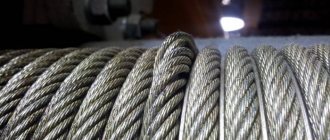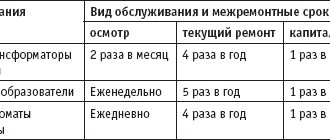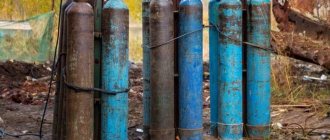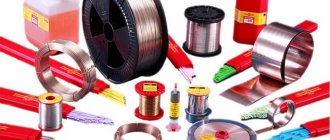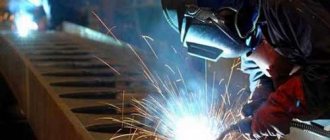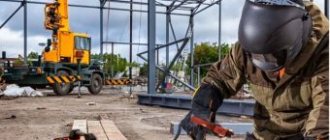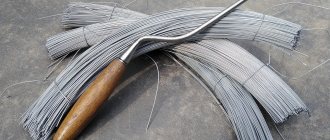Lifting work is classified as potentially dangerous, therefore all equipment used during this work is subject to special requirements in terms of their suitability for use. The condition of all components of lifting equipment is important not only for the safety of cargo, but, first of all, for the safety of the personnel carrying out the work.
The rules and regulations for the operation of such equipment, including the rejection of slings, are established by regulations and PB 10-382-00
,
POT RM-007-98
, etc. For each type of sling, the requirements for safe operation are determined by the relevant sections of
RD 24-SZK-01-01
,
RD 10-33-93
and
RD 11-07-2007
, which determine the timing and composition of control and rejection of lifting slings.
General information
1.1.
Removable load-handling devices and containers are used in the process of lifting and moving goods using lifting structures. Slinging, tying and hooking of solid loads for lifting, moving and lowering them when performing construction, installation, loading and unloading and other work using lifting structures is carried out using removable load-handling devices. Moving small-piece cargo is allowed only in special containers designed for this purpose in order to exclude the possibility of individual parts of the cargo falling out. Bricks are moved on pallets without fencing only when unloading (loading) vehicles onto the ground (and from the ground), unless otherwise specified in the operating manual (instructions) and other operational documents for the container or in the PPR. To lift and move liquid and bulk cargo, special containers are used (tubs, trays, boxes, containers, buckets, etc.).
1.2. Depending on the conditions of work, the geometric dimensions and weight of the load, lifting devices of different designs are used (slings, traverses, grips, etc.). Slings are among the simplest lifting devices in design and are flexible elements with end fastenings and gripping elements of various designs. As a rule, steel wire ropes, less often chains and tapes, are used as a flexible load-bearing element.
1.3. Steel ropes have a high specific load-bearing capacity and flexibility, are much easier to work with and more durable than ropes made from organic plant fibers or steel load chains. A steel wire rope smoothes out dynamic loads and is reliable, since the destruction of the rope does not occur suddenly, like a chain, but the number of broken wires increases gradually, which allows you to monitor the condition of the rope and reject it long before the break.
1.4. The advantages of steel chains compared to steel ropes are their high flexibility, simplicity of design, manufacturability and ability to bend around sharp edges without the use of pads. Significant disadvantages of steel chains are their large mass, the possibility of sudden rupture due to the rapid opening of formed cracks and the need for careful daily monitoring of the condition (wear) of chain links. In addition, steel chains do not allow the application of dynamic loads, and defects in the metal of the chain links are difficult to detect.
1.5. According to the number of branches, slings are divided into single-branch rope (1SC), two-branch (2SC), three-branch (3SC), four-branch (4SC) and universal (USK), single-branch chain (1SC), two-branch (2SC), three-branch (3SC), four-branch ( 4SC) and universal (USC). Simple slings (SK and STs) are used for hanging loads that have special devices (loops, hooks, eyes, bolts, etc.), universal slings are used for slinging loads with a harness. A single-leg sling with a hook or other load-grasping device is usually used to grab and move loads equipped with mounting loops or eyes, brackets, etc.
1.6. Multi-leg slings are used for lifting and moving building parts and structures that have two, three or four attachment points. They are widely used for slinging building elements (panels, blocks, trusses, etc.) equipped with loops or eyes. When using a multi-leg sling, the load must be transferred to all branches evenly, which is ensured by auxiliary connections.
1.7. Universal slings are used when lifting loads that cannot be tied with ordinary slings (pipes, boards, rolled metal, apparatus, etc.).
1.8. Traverses are used for lifting and moving long or large-sized structures or equipment (columns, trusses, beams, apparatus, pipes, etc.). Crossbars are designed to withstand compressive or tensile forces. They protect the load from the compressive forces that occur when the load is tilted and ensure safety when it is moved by a crane. Traverses are hung on the crane hook using a gusset with an eye (ring) or flexible or rigid rods that are hinged, which completely frees them from bending moments. Hanging traverses on a crane hook using rigid and flexible rods leads to loss of useful lifting height. Rope slings at the free end end with hooks of various designs that interact with product staples or pin locks mounted on a traverse with thimbles inserted into the sockets of the lock body. The pin is pulled out manually by the rope attached to it (remote control).
1.9. Grips are the most advanced and safe load-handling devices, the main advantage of which is the reduction of manual labor costs when grabbing a load and placing it in the designed position by a crane. It is advisable to use grippers in cases where it is necessary to move structures of the same type. With grips installed on the slings, you can quickly secure the sling to the rails, channels and beams being lifted. Using connecting links and rigging shackles, the grippers are quickly secured to the slings. The slings can also be used to attach hooks, sheet clamps, and other accessories.
1.10. The most common types of steel technological containers for lifting and moving piece, packaged, semi-liquid and liquid cargo, as well as cargo classified as explosive and fire hazardous, are boxes, tubs, containers, bunkers, containers, pallets and other packaging devices.
Rejection standards for chain slings
The requirements of inter-industry standards for the safe performance of loading and unloading operations RM-07-2008 provide for periodic testing of the performance of cargo slings, including chain slings. Such rejection is carried out by authorized persons at least once every 10 days (with the exception of rarely used slings, for which the rejection period, by agreement with the Gosgortekhnadzor authorities, can be increased until the next use of chain slings).
Chain slings are inspected to identify defects such as the integrity of chains, hooks, staples, grips, the presence of surface cracks, partial damage to the weld, etc.
The criteria for rejecting the devices in question are:
- The absence of a passport for the slings, which indicates the year of manufacture of the product, the dates of its previous inspections, the absence of clearly visible markings on the links, and similar information.
- The difference in the lengths of the individual branches of the sling when it is lifted freely exceeds 15 mm.
- The branch links are integral, but the length of the link is increased (compared to the standard) by more than 5% of the original value.
- The transverse value of the diameter of a chain link at any point of its contact with an adjacent link, bracket or hook is reduced by 8%, and there are signs of wear on the surface of the link - grooves, local notches, etc.
- There are no safety locks on at least one of the connecting elements of the chain sling.
- The metal of hooks, staples, and welded links has an oxide film, surface cracks, hairlines, and the weld is not continuous.
- At least one of the chain links has a transverse deformation, which consists in the rotation of the link relative to the common axis of the sling.
A general check of the load-bearing capacity of chain slings is performed as follows. The product is loaded with static force, which is 4 times greater than that indicated in the passport. The force is released no earlier than after 3 minutes. A chain sling, which after such a test has not received the above damage and deformation, is considered suitable for further use.
If at least one of the specified deviations from the norm is detected, the chain sling is rejected, and its repair is not allowed. If the product is under manufacturer’s warranty, then it is replaced with a suitable chain sling of the same design within the time period specified in the passport.
The price of chain slings depends on their design and permissible load capacity. For devices of type 1SC it ranges from 1500...15000 rubles, 2SC - 2000...20500 rubles, 4SC - 4000...60000 rubles. per set.
Wall chaser attachment for an angle grinder. How to avoid buying extra tools?
Reducer for oxygen cylinder. Design and principle of operation
Exploitation
3.1. The specialist responsible for maintaining lifting structures in working condition is obliged to ensure that removable lifting devices and production containers are maintained in good condition (if their maintenance in good condition is not entrusted to other persons by order) by conducting periodic inspections, maintenance and repairs within the time limits established by the schedule, systematic monitoring of the correct maintenance of the inspection log and timely elimination of identified faults, as well as personal inspection of lifting devices and containers within the established time frame.
3.2. The specialist responsible for the safe performance of work using lifting structures is obliged not to allow untested, unmarked or damaged removable lifting devices and containers into work, and to provide slingers with distinctive signs.
3.3. Personnel assigned to carry out cargo hooking work, incl. in hanging lifting structures on hooks, slinging and tying loads moved by lifting structures using load-handling devices, must have a level of qualifications corresponding to the profession of slinger.
The same requirement applies to personnel of the main working professions, whose duties include hanging cargo on a hook without preliminary strapping (load that has loops, eyes, pins, located in buckets, tubs, containers or other containers), as well as in cases when the load is grabbed by semi-automatic gripping devices.
3.4. For lifting structures controlled from the floor, hooking a load onto a hook without preliminary strapping is permitted to be performed by personnel of basic working professions who have undergone testing of their skills in hooking loads and training at the workplace.
3.5. A graphic representation of slinging and hooking methods should be handed out to slingers and crane operators or posted at work sites.
3.6. Faulty load-handling devices, as well as devices that do not have tags (stamps), should not be located in the work areas. Unmarked and damaged containers are not allowed in the work areas.
3.7. Loads must be slinged in accordance with slinging diagrams. To sling a load intended for lifting, slings must be used that correspond to the weight and nature of the load being lifted, taking into account the number of branches and their angle of inclination; General purpose slings should be selected so that the angle between their branches does not exceed 90°.
3.8. The connections between the hook of the lifting machine and the suspensions, loops and thimbles of the slings must be reliable. The sling suspension must be secured with a hook latch. The mounting loop must be secured with a latch in the hook link of the sling.
3.9. In order to prevent loads from falling during lifting and moving them by lifting structures, the following slinging rules should be observed:
when tying the load, the slings must be applied without knots or twists;
Under sharp corners of metal weights (channels, angles, I-beams) it is necessary to place pads. In this case, it is necessary to take into account the location of the center of gravity of the load. The sling should be placed under the load in such a way as to prevent it from slipping while lifting the load. The load must be tied in such a way that during its movement, the fall of its individual parts is prevented and a stable position of the load is ensured during movement. To do this, slinging of long loads (poles, logs, pipes) must be done in at least two places;
The ends of the multi-leg sling that are not used for hooking must be strengthened so that when moving the load by crane, the possibility of these ends touching objects encountered along the way is excluded.
3.10. When moving a load, load-handling device or container horizontally, it should first be lifted 500 mm above equipment, building structures and other objects encountered along the way.
3.11. It is allowed to lower the transported load only to the place intended for this purpose, where the possibility of falling, tipping over or sliding of the installed load is excluded. At the place where the load is installed, pads of appropriate strength must first be laid so that the slings can be easily and without damage removed from under the load.
3.12. When carrying out work with the use of PS, lifting a load covered with earth or frozen to the ground, laid down by other loads, as well as releasing pinched slings, ropes, chains using a lifting machine is not allowed.
What is checked when rejecting textile slings?
During the inspection, the specialist must pay attention to the following norms and rules for rejecting textile slings, in which the use of textile slings is prohibited:
- Checking the mark on the sling - if the information on the tag cannot be read, then this instrument is considered damaged and textile slings of this type must be rejected;
- Strength test of units of load-bearing parts of elements;
- Are there any transverse cuts or damage to the tape (for longitudinal cuts, the length limit is 10% of the total length of the tape; in the case of single cuts, the length cannot exceed 50 mm);
- Is there any delamination of the sling strips? If there are patches totaling half a meter in one part of the sling, the slings are considered defective;
- Whether the instrument was damaged by chemicals - if the damaged area exceeds 10% of the total length of the sling, textile slings are rejected;
- Level of belt contamination - if traces of oil, paint, resin or other substances are found on more than 50% of the length of the slings, it must be replaced;
- Are there any delaminations of the threads of the load-bearing tapes of the slings?
The procedure for inspection and rejection of removable lifting devices and containers
4.1. According to the requirements of the “Safety Rules for hazardous production facilities where lifting structures are used” (approved by order of Rostechnadzor dated November 12, 2013 N 533), slingers and crane operators (operators) must inspect lifting devices before their use, and acceptance indicators should be used, given in their manual (instructions) for their operation.
4.2. Specialists responsible for maintaining lifting structures in working condition and specialists responsible for the safe performance of work using lifting structures inspect lifting devices within the following periods:
traverse, pincers, grippers and containers - every month;
slings (except for rarely used ones) - every 10 days;
rarely used removable lifting devices - before starting work.
4.3. When inspecting rope slings, it is necessary to pay attention to the condition of the ropes, thimbles, hooks, hangers, locking devices, clips, carabiners and their attachment points.
4.4. To assess the safety of using ropes, the following criteria are used:
the nature and number of wire breaks, including the presence of wire breaks at the end seals, places where wire breaks are concentrated, the intensity of the increase in the number of wire breaks;
strand break;
surface and internal wear;
surface and internal corrosion;
local reduction in rope diameter, including core rupture;
deformation in the form of waviness, basket-like shape, extrusion of wires and strands, crushing of strands, creases, etc.;
damage due to temperature effects or electrical arcing.
4.5. The rope sling is subject to rejection if the number of visible breaks in the outer wires exceeds that indicated in the table.
| Double lay rope slings | Number of visible wire breaks in a section of rope sling length | ||
| 3d | 6d | 30d | |
| 4 | 6 | 16 | |
Note. d is the diameter of the rope, in millimeters.
4.6. Rejection of sling parts (rings, loops and hooks) should be carried out:
in the presence of cracks;
when the surface of elements wears out or local dents lead to a decrease in cross-sectional area by 10%;
in the presence of residual deformations leading to a change in the original size of the element by more than 5%.
4.7. The following slings are not allowed for use:
having defects;
if the marking tag is missing or damaged;
with deformed thimbles or their wear with a reduction in cross-section by more than 15%;
having cracks on pressed bushings or when their size changes by more than 10% from the original;
with signs of rope displacement in the braid or bushings;
with damaged or missing braids or other protective elements in the presence of protruding ends of the wire at the braiding point;
with hooks without safety locks.
4.8. The chain sling is subject to rejection if the following defects are found:
broken link;
bending or wear of the hook in the link is more than 10% of the original size;
chain link elongation of more than 3% of the original size;
reduction in the cross-sectional diameter of a chain link due to wear of more than 10%.
4.9. When inspecting grippers, it is necessary to check the condition of the working surfaces in contact with the load. If they have a notch, then blunting or chipping of the teeth is not allowed. The gripper must be rejected if bends, breaks in the arms or wear and damage to the connecting links are detected. Metal traverses consisting of beams, struts, frames and other elements are subject to rejection if deformations with a deflection of more than 2 mm per 1 m of length are detected, cracks in places of sharp bends or changes in the cross-section of welded elements, as well as damage to fastening and connecting links.
4.10. When inspecting containers, you must especially carefully check:
the appearance of cracks in gripping devices for slinging;
serviceability of actual devices and lid locking devices;
absence of defects in welded joints, integrity of markings.
The container is rejected in the following cases:
the container is not marked;
the purpose of the container is not indicated;
there are faulty sling units;
the sides are dented or torn;
there are cracks and other defects in welded joints.
4.11. When inspecting polymer-based textile slings, it is necessary to pay attention to the condition of the tapes, seams, hooks, staples, locking devices, clips, carabiners and places of their fastenings. Slings should not be allowed to work if:
there is no mark (tag) or the information about the sling, which contains information about the manufacturer and load-carrying capacity, is not readable;
there are knots on the load-bearing tapes of the slings;
there are transverse cuts or tears in the tape, regardless of their size;
there are longitudinal cuts or tears in the tape, the total length of which exceeds 10 percent of the length of the tape of the sling branch, as well as single cuts or tears more than 50 millimeters in length;
there are local delaminations of the sling tapes (except for places where the edges of the tapes are sealed) over a total length of more than 0.5 meters on one extreme seam or on two or more internal seams, accompanied by a break in three or more seam lines;
there are local delaminations of the sling tapes in the place where the edges of the tape are sealed for a length of more than 0.2 meters on one of the outer seams or on two or more internal seams, accompanied by a tear in three or more seam lines, as well as peeling of the edge of the tape or stitching of the tapes at the loop along the length more than 10 percent of the length of the sealing (stitching) of the ends of the tapes;
there are surface breaks of the belt threads with a total length of more than 10 percent of the belt width, caused by mechanical action (friction) of the sharp edges of the load;
there is damage to the belts from exposure to chemicals (acid, alkali, solvent, petroleum products) with a total length of more than 10 percent of the belt width or sling length, as well as single damage of more than 10 percent of the belt width and a length of more than 50 millimeters;
there is bulging of threads from the sling tape at a distance of more than 10 percent of the tape width;
there are through holes with a diameter of more than 10 percent of the width of the tape from the impact of sharp objects;
there are burnt through holes with a diameter of more than 10 percent of the width of the tape from exposure to splashes of molten metal or the presence of three or more holes with a distance between them of less than 10 percent of the width of the tape, regardless of the diameter of the holes;
there is contamination of the belts (petroleum products, resins, paints, cement, soil) of more than 50 percent of the sling length;
there is a combination of all of the above defects in an area of more than 10 percent of the width and length of the sling;
there is loosening or wear of more than 10 percent of the width of the sling loops.
It is prohibited to use slings with the following defects and damage to metal elements (rings, loops, staples, pendants, clips, carabiners, links):
cracks of any size and location;
wear on the surface of elements or the presence of local dents, leading to a decrease in cross-sectional area by 10 percent or more;
the presence of residual deformations leading to a change in the original size of the element by more than 3 percent;
damage to threaded connections and other fasteners.
4.12. The results of inspection of removable lifting devices and containers must be recorded in a special journal.
Features of cable condition monitoring
In accordance with the requirements of the governing document RD ROSEK 012-97, regardless of where the steel cable (not rope) is used, it must be checked before the start of each work shift.
A detailed assessment of the condition must be carried out at least once every 10 days. Defects must be detected through the use of flaw detectors. Their purpose:
- exercise control over maintaining the diameter of the metal section specified in the passport;
- detect the presence of external and internal corrosion;
- detect the break of one or more rope elements.
Steel material
Increased requirements are placed on compliance with steel rope rejection standards in the following places:
- where fastenings are made;
- where the rope comes into contact with fixed and moving structural elements;
- at the ends of the cable.
For a full assessment, several different options are used:
- an indirect method in which linear and angular damage to the rope structure is calculated;
- visual assessment. Allows you to determine the safety of visible surfaces;
- flaw detection using magnetic, x-ray and ultrasonic radiation;
- instrumental measurement. Allows you to identify the degree of wire wear, changes in cable diameter, and changes in straightness values.
Rope driving mechanism: basic assessment
Repair
5.1. Restoration repairs involving welding of load-handling devices, containers and their elements must be carried out in specialized organizations that have technical means and qualified specialists.
5.2. Routine repair of elements of lifting devices and containers without the use of welding (straightening parts, sealing ends of ropes, replacing fasteners, etc.) must be performed by mechanics for the repair and maintenance of hydraulic lifting equipment, in accordance with the repair documentation and under the guidance of a specialist responsible for the maintenance of lifting structures in working condition
5.3. Information about the quality of individual repair work must be entered in the repair log. When accepting a lifting device or container from repair, it is necessary to inspect and test it in order to determine the degree of reliability.
Marking of slings and its features
During production, slings are marked - a sign is applied to the product that identifies the product by properties. Unmarked specimens are rejected and the use of such slings is prohibited. The presence of clearly readable markings ensures the safety of these devices when lifting loads. If the marking element is lost, the sling is also considered unsuitable for further use.
High-quality affixing of such marks is an important event, without which production cannot do.
Methods for marking are reflected in GOST 25573-82, according to which a metal tag is attached to each product or it is branded. The tag contains information about the plant (sign, address), product number, its type and information about quality tests carried out (testing is dated). The other side of the tag may indicate manufacturing standards. An important characteristic is load capacity.
Markings must be made using paint that is wash-resistant. Tags are possible not only from metal, but also from fabric with appropriate treatment with protective compounds. The color of the text should be in contrast to the tag so that the inscriptions are clearly visible.
Light-colored tags are marked with dark inscriptions, and dark labels are marked with white text. Textile slings are marked directly on the tape with durable paint in a place that is not subject to abrasion. The inscription must be clearly legible until the end of use of the product.
The dimensions of the tags are indicated in the design documentation and correspond to the design project. The material and shape are not exactly predetermined. The main requirements for labeling are the ability to be clearly read throughout the service life.
Each type of sling corresponds to certain types of tags. Metal tags are usually attached to chain or rope slings. They are made of steel sheets up to a millimeter thick, as well as aluminum. To apply inscriptions on metal, the impact method or the impact-point method is used. Thermal printing with ink that is not subject to abrasion is also used, as well as the perforation method. Textile slings are not equipped with metal tags to avoid damaging them. Modern materials - vinyl, leather, polypropylene tags with thermal printing.
The shape of the tag is determined by the sling manufacturer himself. Simple geometric shapes will not be difficult to produce in the same production. Sometimes this is a stylish design that reflects the originality of the company.
There is no special meaning attached to the tag configuration, but sometimes it is given additional functionality. For example, Rud's chain sling tags have cut-outs that help you analyze the sling's condition without additional tools. Non-conforming specimens will be rejected if they do not pass the Rud tag test.
Mandatory information included in the labeling:
- Type (material and number of branches).
- Load capacity (tons).
- Length in millimeters.
- Number.
- Testing (date).
- Factory name.
For example, STC stands for textile ring slings, and STP stands for textile loop slings. 1ST means 1 branch in a textile sling, and 2 SK means a rope sling made of 2 branches. The tag also contains information about the carrying capacity, for example 2 tons.
Lifting slings: types
Chain
They are a chain of steel links welded together. They are particularly durable and easy to use. Additional benefits include the ability to handle sharp-edged loads, as well as rapid repair and restoration if damage or ruptures occur. Chain slings can be used at low temperatures, in acidic and alkaline environments, and in the presence of open fire. Their only drawback is their heavy weight. Common models are:
- 1SC. Single-leg group of slings. Can be used at any ambient temperature. The exact range is indicated in the product passport.
- 2SC. Two-branched. Thanks to the reinforcement, they are able to move especially heavy loads: under critical load, the links stretch, but do not break.
- 3SC. Three-legged slings are used in construction and rigging work. Some models allow you to adjust the length of each branch separately.
- 4SC. Four-leg slings are used for lifting and moving loads with non-standard shapes. Provides grip strength.
- USC. Ring or universal sling. Operates in extreme temperature conditions, suitable for working with pipes and loads with sharp edges.
When marking chain slings, data such as: load capacity (measured in tons), length (measured in millimeters), serial number, date of manufacture and name of the manufacturer are indicated.
Cable cars
Made from steel wire: thin metal threads are woven into strands, which allows you to quickly detect abrasions and the possibility of rupture. Operate in a temperature range from -40 to +400 degrees Celsius. Strength characteristics comply with GOST. The greater the length and load capacity, the higher the price. The most common modifications:
- 1SC. Consists of a single rope branch, produced by braiding or crimping with an aluminum sleeve.
- 2SC. It has two branches and is often used for rigging work in warehouses.
- 4SK. Consists of 4 branches attached to one durable ring. Due to its strength, it is used during construction work and when lifting heavy loads in production.
- SKK (USK2). Ring type - the hook is inserted under the load, bends around its diameter and hooks onto its branch.
- SKP (USK1). This sling designation is almost the same as a single-branch sling, but it may not have a hook, and the branches are woven together in the form of a loop.
2.1. General requirements
2.1.1. Load slings must be manufactured in accordance with the requirements of this RD, Rules for the design and safe operation of load-lifting cranes,
as well as design documentation approved in accordance with the established procedure.
The design and manufacture of cargo slings must be carried out in organizations and enterprises that have a permit (license) from the Gosgortekhnadzor of Russia and have qualified specialists and technical means to ensure the design and manufacture of slings in full compliance with the requirements of this regulatory document.
To obtain a permit (license) for the production of slings, the manufacturer must submit to the territorial bodies of Gosgortekhnadzor the documents specified in clause 2.1 of the Regulations on the procedure for issuing special permits (licenses) for activities associated with increased danger of industrial production (facilities) and work, as well as ensuring safety during the use of subsoil, approved by Resolution of the Gosgortekhnadzor of Russia dated 07/03/93 No. 20.
The application of the sling manufacturer must be accompanied by other documents confirming the possibility and readiness of high-quality production of slings, including:
technical specifications for manufacturing, approved in accordance with the established procedure;
working drawings of slings;
description of the technological process for manufacturing slings (technological maps);
certificates for ropes and chains;
certificate of availability of certified specialists (if welding work is required).
A permit (license) for the manufacture of slings is issued by the territorial bodies of the Gosgortekhnadzor of Russia based on the results of an inspection of the manufacturer and consideration of the documentation submitted by it. Slings manufactured for third-party organizations must be provided with a passport (the form of the Sling Passport is given in).
2.1.2. Calculation of ropes and chains of slings used both for direct tying of cargo and for capturing the latter using end links is carried out in tension.
2.1.3. Determination of forces in ropes and chains of two-, three- and four-branch slings in the absence of additional requirements is carried out based on the condition that the angles between the branches do not exceed 90° ().
Rice. 1.
Slinging a load of two ( a)
), three- (
b
) and four-legged (
c
) slings
2.1.4. Calculation of three- and four-leg slings in the absence of a guarantee of uniform distribution of loads between the branches is carried out based on the condition that the load is held by only two branches.
2.1.5. When calculating under the action of a rated load, the safety factor for ropes and chains in relation to the breaking load specified in their certificate must be at least 6.0 and 5.0, respectively.
2.1.6. When checking the cross-sectional strength of the working part of the sling hook and taking into account the curvature of the latter, the safety margin in relation to the yield strength of the material is taken to be no less than 1.2, and for the cross-section of the branches of the hook head with an eye when calculating tensile strength - no less than 1.5.
2.1.7. When calculating loops of all types, their straight sections are calculated for tension; The safety margin relative to the tensile strength of the material must be at least 5.0. For curved sections, when calculating taking into account their curvature, the safety factor for the inner side of the section should be at least 1.1 in relation to the yield strength of the material, and on the outer side - at least 1.3 in relation to the strength of the material.
2.1.8. The load capacity of chain slings intended for moving cargo with a temperature above 300 °C, but not more than 500 °C, is reduced by 25%, and above 500 °C - by 50%.
2.1.9. Rope slings, the branches of which are made of ropes with an organic core, may be used for transporting goods with a temperature not exceeding 100 ° C, and slings, the branches of which are made of ropes with a metal core, with the ends of the rope sealed by crimping aluminum bushings - not higher than 150 °C.
The load capacity of slings with branches made of rope with a steel core when moving loads having a temperature of 250 to 400 ° C is reduced by 25%; movement of cargo with a temperature above 400 °C is not allowed.
2.1.10. The deviation in the length of the branches used to complete one sling should not exceed 1% of the length of the branch.
Marking and load capacity of chain slings
First of all, attention is paid to the markings used and the load capacity indicator. Chain slings are a classic product that consists of individual links. The key feature is the number of chains
According to it, the following types of circuits are distinguished:
The key feature is the number of chains. According to it, the following types of circuits are distinguished:
- Slings with one branch are marked 1СЦ. They are much cheaper, but such chain slings cannot be used for transporting heavy workpieces.
- The version with two branches is more durable. In this case, the marking or designation is 2СЦ.
- The three branches are designated 3SC.
- The version with four branches is marked 4SC. Due to this combination of individual links, the required strength can be achieved.
- They include into a separate group products with a single chain branch, which can be made in the open and closed type, as well as in the form of a ring. Marking in an open circuit VTs, in the form of a ring USTS-K.
The most complex versions are made in a combined form. They are characterized by higher strength.
Operation of chain slings can be carried out exclusively taking into account the load capacity indicator. This characteristic depends on the strength of the individual parts of the product used. As strength increases, durability increases significantly. In practice, the following versions are widely used:
- The third class is designed for a carrying capacity of no more than 100 kilograms.
- The fifth class can be used for a load of no more than 300 kilograms.
- The eighth has a carrying capacity of 800 kilograms.
- The tenth class is designed for a load of up to 1200 kilograms.
- The twelfth is characterized by properties that allow it to transport cargo weighing up to 3150 kilograms.
A higher indicator causes a significant increase in ductility, due to which the strength is reduced by 10-15%. These and many other points are taken into account when choosing the most suitable product.
Within each class, classification is also carried out according to the minimum diameter. Do not forget that there is no GOST for such a product yet; regulatory requirements are specified in RD 11-07-2007. During production, the following points are also taken into account:
- Strength class.
- Conventional name.
- The temperature range at which the circuit can be used.
- Length and some other points.
Today, chain slings are equipped not only with gripping hooks, but also with end stops. The strength class depends on the type of material used in manufacturing and some other points.
